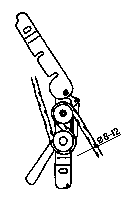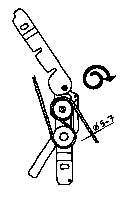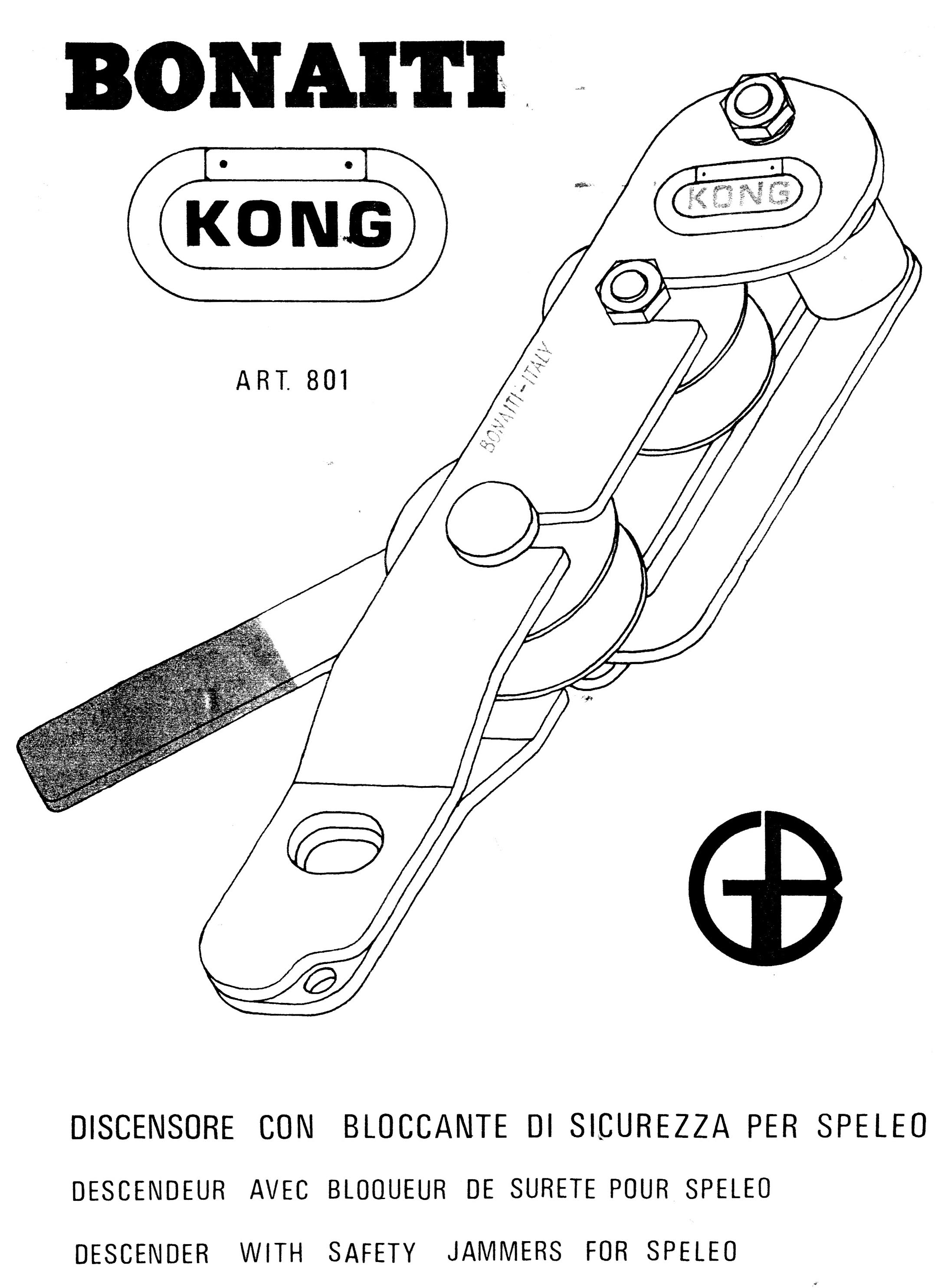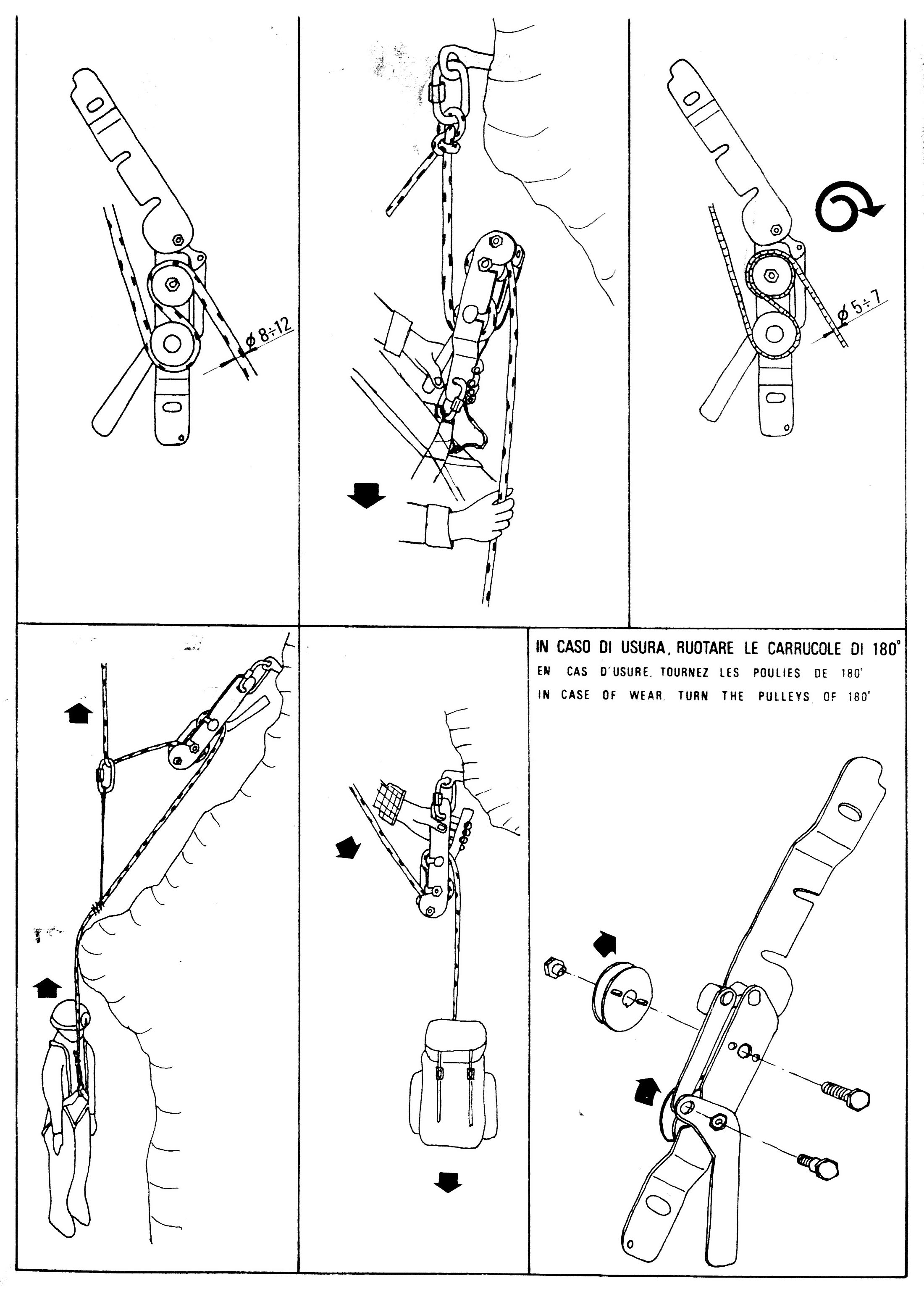Overview
[ Top
| Kong-Bonaiti, v. B
| Kong, v. A
| Kong, v. B
| Kong, v. B (Modified)
| Kong Pirata
| Return to Stop Bobbins
]
Kong-Bonaiti, Version A
(#3024)
Technical Details
I acquired my Kong-Bonaiti, Version A from Avi Basri in 2021.
Version A is 239 mm. tall, 60 mm. wide, 31 mm. thick, and weighs 399 g.
The side plates are very long, with a cast steel autostop cam
mounted above the two bollards. The pivoting side plate pivots
about the cam bolt rather than the lower bollard bolt as in most
other designs. The upper bollard is bolted through its center
to the fixed side plate, with two roll pins provided to prevent
rotation. The lower bollard rotates on a custom axle bolt bolted
to the fixed side plate. A handle assembly mounted on the outside
of the fixed side plate rotates on the shoulder nut attached to
this bolt. A shim serves as a spacer between the side plate and
handle assembly. The handle grip is molded phosphorescent green
plastic. A second bolt passes through the handle, a connecting
arm, a shim, and into a threaded steel insert in the lower bollard.
A second insert is provided for reversing the bollard. The other
end of the connecting arm is riveted to the autostop cam. Friction
from the passage of the main rope causes the lower bollard to
rotate, rotating the handle and pulling the connecting rod down.
This pulls the autostop cam against the rope above the upper bollard,
thus ideally arresting the descent. The handle is used to keep
the cam disengaged during normal descent.
The attachment point is a 15 by 22 mm. oval hole near
the bottom of the two side plates. The hole is oriented horizontally,
allowing two maillons to ride side-by-side. Below these holes
is a 6 mm. hole in the fixed side plate for attaching a piece
of accessory cord. A cutout in the pivoting side plate provides
clearance.
The pivoting side plate is stamped with the Kong logo, "BONAITI-ITALY." The plastic handle has "PHOSPHORESCENT" in molded letters.
Comments
Versions A does not have the "Kg 1500" stamping that Version B has.
[ Top
| Kong-Bonaiti, v. A
| Kong, v. A
| Kong, v. B
| Kong, v. B (Modified)
| Kong Pirata
| Return to Stop Bobbins
]
Kong-Bonaiti, Version B
(#433)
Technical Details
I acquired this descender from Speleoshoppe in 1982.
Version A is 239 mm. tall, 60 mm. wide, 30 mm. thick, and weighs 400 g.
The side plates are very long, with a cast steel autostop cam
mounted above the two bollards. The pivoting side plate pivots
about the cam bolt rather than the lower bollard bolt as in most
other designs. The upper bollard is bolted through its center
to the fixed side plate, with two roll pins provided to prevent
rotation. The lower bollard rotates on a custom axle bolt bolted
to the fixed side plate. A handle assembly mounted on the outside
of the fixed side plate rotates on the shoulder nut attached to
this bolt. A shim serves as a spacer between the side plate and
handle assembly. The handle grip is molded phosphorescent green
plastic. A second bolt passes through the handle, a connecting
arm, a shim, and into a threaded steel insert in the lower bollard.
A second insert is provided for reversing the bollard. The other
end of the connecting arm is riveted to the autostop cam. Friction
from the passage of the main rope causes the lower bollard to
rotate, rotating the handle and pulling the connecting rod down.
This pulls the autostop cam against the rope above the upper bollard,
thus ideally arresting the descent. The handle is used to keep
the cam disengaged during normal descent.
The attachment point is a 15 by 22 mm. oval hole near
the bottom of the two side plates. The hole is oriented horizontally,
allowing two maillons to ride side-by-side. Below these holes
is a 6 mm. hole in the fixed side plate for attaching a piece
of accessory cord. A cutout in the pivoting side plate provides
clearance.
The pivoting side plate is stamped with the Kong logo, "BONAITI-ITALY"
and "Kg 1500." The plastic handle has "PHOSPHORESCENT" in molded letters.

 Comments
Comments
The autostop feature on this descender differs from the others,
and has several disadvantages. First, and most important, I find
that it simply does not work. I can easily rappel with the autostop
feature fully engaged. Second, it greatly increases the length
of the descender. Finally, it is too complicated, with too many
pivoting joints for mud and sand to enter. On the positive side,
the workmanship is good, and I like the idea of a phosphorescent
handle, even if its practical utility is negligible. The accessory
cord hole should be used to tie the descender to one’s harness,
since there is no quick attach feature.
Kong recommends rigging this stop bobbin in the standard "S"
configuration when using ropes ranging in diameter from 8 to 12 mm.
They recommend using two wraps on the top bollard for ropes in the
5 to 7 mm. diameter range. I consider most such ropes to
be too thin for safe rappelling and recommend against their general
use.
[ Top
| Kong-Bonaiti, v. A
| Kong-Bonaiti, v. B
| Kong, v. B
| Kong, v. B (Modified)
| Kong Pirata
| Return to Stop Bobbins
]
Kong, Version A
(#1434)
Technical Details
I acquired my Kong, Version A from Clear Out Our Stuff on eBay in 2015.
Version A is 232 mm. tall, 55 mm. wide, 27 mm. thick, and weighs 398 g.
The side plates are shorter than those on the Kong-Bonaiti, and the
pivoting side plate pivots about the lower bollard bolt as in
most other designs.
The upper bollard is bolted through its center to the fixed
side plate, with two roll pins provided to prevent rotation. The
upper bollard is 45 mm. in diameter and 13.6 mm. thick,
with a 10 mm. wide, rounded V-shaped groove turned to give
an inner diameter of 35 mm. The lower bollard is 50 mm.
in diameter, with a shallow U-shaped groove giving a 45 mm.
inner diameter. Two cuts reduce the lower bollard to a wedge shape.
The upper cut is 28 mm. long, the lower 34 mm., and the
angle between the cuts is about 30 degrees. The lower bollard
rotates on a custom axle bolt bolted to the fixed side plate.
A handle assembly mounted on the outside of the fixed side plate
rotates on the shoulder nut attached to this bolt. The handle
grip is molded black plastic. A second bolt passes through the
handle, a connecting arm, a shim, and is threaded into the lower bollard. A second hole is provided
for reversing the bollard. The other end of the connecting arm
is riveted to the autostop cam. Friction from the passage of the
main rope causes the lower bollard to rotate, rotating the handle
and pulling the connecting rod down. This pulls the autostop cam
against the rope above the upper bollard, thus ideally arresting
the descent. The handle is used to keep the cam disengaged during
normal descent.
The pivoting side plate is stamped with the Kong logo, "ITALY,"
a rigging illustration, "MAX ↔ 22 kN," and "USE ROPE ø 9-12 mm."and "Kg 1500." The plastic handle has "PHOSPHORESCENT."
Comments
The significant improvement is the opening mechanism, which facilitates detaching and attaching the ascender at rebelays.
The stop mechanism is no more reliable than that on the Kong-Bonaiti.
[ Top
| Kong-Bonaiti, v. A
| Kong-Bonaiti, v. B
| Kong, v. A
| Kong, v. B (Modified)
| Kong Pirata
| Return to Stop Bobbins
]
Kong, Version B
(#522)
Technical Details
I acquired two of these descenders from Inner Mountain Outfitters,
the first in 1996 and the second in 1997. I modified the second one as discussed in the next entry.
Version B is 230 mm. tall, 65 mm. wide, 32 mm. thick, and weighs 397 g.
The upper bollard is bolted through its center to the fixed
side plate, with two roll pins provided to prevent rotation. The
upper bollard is 45 mm. in diameter and 13.6 mm. thick,
with a 10 mm. wide, rounded V-shaped groove turned to give
an inner diameter of 35 mm. The lower bollard is 50 mm.
in diameter, with a shallow U-shaped groove giving a 45 mm.
inner diameter. Two cuts reduce the lower bollard to a wedge shape.
The upper cut is 28 mm. long, the lower 34 mm., and the
angle between the cuts is about 30 degrees. The lower bollard
rotates on a custom axle bolt bolted to the fixed side plate.
A handle assembly mounted on the outside of the fixed side plate
rotates on the shoulder nut attached to this bolt. The handle
grip is molded black plastic. A second bolt passes through the
handle, a connecting arm, a shim, and into a threaded steel insert
in the lower bollard. A second hole (sans insert) is provided
for reversing the bollard. The other end of the connecting arm
is riveted to the autostop cam. Friction from the passage of the
main rope causes the lower bollard to rotate, rotating the handle
and pulling the connecting rod down. This pulls the autostop cam
against the rope above the upper bollard, thus ideally arresting
the descent. The handle is used to keep the cam disengaged during
normal descent.
The attachment point is a 13.4 by 26.9 mm. vertical oval
hole near the bottom of the two side plates. The hole on the pivoting
side plate is cut away to form a hook, and a spring-loaded stamped
gate is fixed to the side plate.
The pivoting side plate is stamped with the Kong logo, "ITALY,"
an icon showing how to rig the device, "Max <-> 22
kN," and "USE ROPE ø 9-12 mm."
Version B looks prettier than Version A, but the functionality is essentially the same.
The bollards seem to be much softer than those on Version A, and a steel insert is needed for the bolt from the handle. These bollards will wear more quickly than the previous ones.
[ Top
| Kong-Bonaiti, v. A
| Kong-Bonaiti, v. B
| Kong, v. A
| Kong, v. B
| Kong Pirata
| Return to Stop Bobbins
]
Kong, Version B (modified)
(#528)
Technical Details
I acquired two Version B descenders from Inner Mountain Outfitters,
the first in 1996 and the second in 1997. I modified the second one by disassembling the descender and reversing the lower bollard.
In the modification process, I found that
the bollard was soft and easily damaged. I can't say that I've
noticed a great difference in friction between the two arrangements, so I am not sure why Kong made the bobbin reversible.
[ Top
| Kong-Bonaiti, v. A
| Kong-Bonaiti, v. B
| Kong, v. A
| Kong, v. B
| Kong, v. B (Modified)
| Return to Stop Bobbins
]
Kong Pirata
(#2553)
Technical Details
I acquired my Kong Pirata from Karst Sports in 2020.
My Kong Pirata is 92 mm. tall, 59 mm. wide, 43 mm. thick, and weighs 421 g.
The front and rear plates are tall, irregular-shaped plates cut from 3 mm. aluminum alloy and then anodized. The rear plate remains stationary in use. It has a stepped cylindrical auxiliary bollard riveted in place to an extension at the top left of the plate, a stationary bollard riveted below this along the central axis, an axle for the lower bollard and handle assembly 48 mm. below this, and a 15 mm. wide, 27 mm. tall attachment hole at the bottom.
The front side plate rotates on the lower bollard axle. The plate has a shallow indentation at the top left that rests against the auxiliary bollard when the gate is closed. A notch cut in the left side lets plate clear the top bollard pin while opening and closing. The lower portion of the plate has a hook with a spring-loaded stamped stainless steel sheet metal gate riveted above. When closed, the gate and hook form a 15 mm. wide, 18 mm. high attachment point.
The top, auxiliary bollard is 7.65 mm. in diameter for the first 14.8 mm. from the rear plate, then enlarges to 8.7 mm. for 4.2 mm. before ending with a 13.8 mm. cap. The axles for the two main bollards have similar dimensions. The top main bollard is cast from stainless steel. It is 41 mm. in diameter and 14.7 mm. thick. It has a 2.8 mm. deep U-shaped rope groove on its periphery. A flat area spanning about 60° truncates the bollard at the 7 o’clock position. The bollard is skeletonized to reduce its weight. A pin pressed into to the lower bollard passes through a 3.9 mm. hole in the rear frame, keeping the upper bollard from rotating.
The bottom bollard is also a skeletonized stainless steel casting. It has a ribbed nose with three ridges at the 10 o’clock position, a flat top with a shallow U-shape rope groove that starts near the center and increases in depth toward the right, a rounded nose at the 2 o’clock position, a flat right side, a rounded bottom with a shallow U-shaped rope groove, and a flat right side.
handle assembly mounted on the outside
of the fixed side plate rotates on the shoulder nut attached to
this bolt. A shim serves as a spacer between the side plate and
handle assembly. The handle grip is molded phosphorescent green
plastic. A second bolt passes through the handle, a connecting
arm, a shim, and into a threaded steel insert in the lower bollard.
A second insert is provided for reversing the bollard. The other
end of the connecting arm is riveted to the autostop cam. Friction
from the passage of the main rope causes the lower bollard to
rotate, rotating the handle and pulling the connecting rod down.
This pulls the autostop cam against the rope above the upper bollard,
thus ideally arresting the descent. The handle is used to keep
the cam disengaged during normal descent.
The handle assembly sits behind the rear plate. It consists of an aluminum arm and a plastic handle. The arm rotates on the lower bollard axle. A pin pressed into the lower bollard passes through a slot in the rear plate and engages a hole in the handle arm, causing the two to rotate together. A plastic
handle is riveted to an extension of the lower bollard at about the seven o’clock position.
The handle is spring-loaded upwards to facilitate carrying.
The pivoting front plate is marked with the Kong logo, "Italy,"
a rigging diagram, "CE0426," a book-with-an-"i" icon, "EN12841:08/C," "100 kg," a rope icon, "• Ø10 ÷ 12 mm," "200 kg," a rope icon, "• Ø11 ÷ 12 mm," "PIRATA," "801.060," "Made in Italy," and "193055 19 0132."
Comments
The revised autostop handle is differs markedly from its predecessors, and anyone making the transition would be wise to spend time to develop new "muscle memory" before using the new version in the field. Here are some of my initial impressions, based in part on my own preferences and physique:
- The autostop feature holds my weight (900 N) securely, something that the other descenders on this page fail to do. For this reason alone, I prefer the Pirata to the others.
- Releasing the autostop to descend requires pulling down on the handle. I found this to be more awkward than the simple squeezing technique used for earlier versions and most similar stop bobbins.
- Like previous versions, the released autostop provides too little friction for my weight and taste. I do not enjoy rappelling with the autostop fully disengaged. "Feathering" the stop feature is not recommended on any stop bobbin.
- Stainless steel bollards should wear better than aluminum alloy bollards, but they are somewhat faster and do not dissipate heat as well.
- The Pirata is shorter than the other descenders on this page, but it is thicker. These are not big differences, but they are noticeable.
There is a lot of information printed on the front to keep you intellectually engaged. Although holding a Ph. D. in linguistics and having the ability to read hieroglyphs in thirty ancient languages may certainly help, it is possible to decode what all the codes mean without first obtaining these credentials. A secret decoder ring may help.
[ Top
| Kong-Bonaiti, v. A
| Kong-Bonaiti, v. B
| Kong, v. A
| Kong, v. B
| Kong, v. B (Modified)
| Kong Pirata
]




 Comments
Comments
